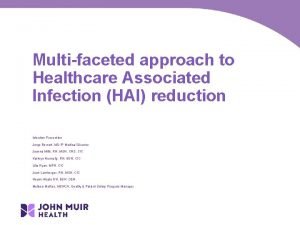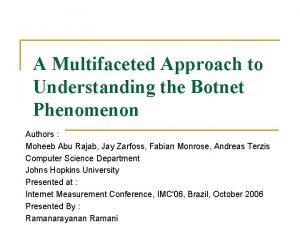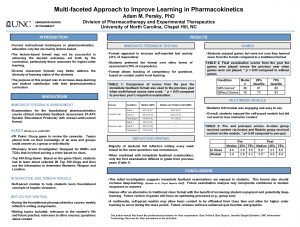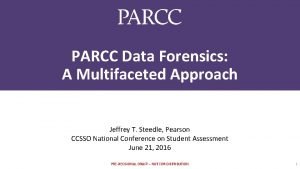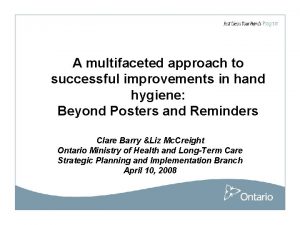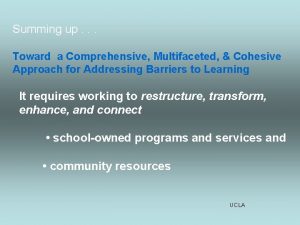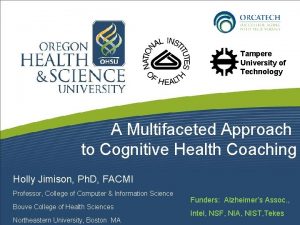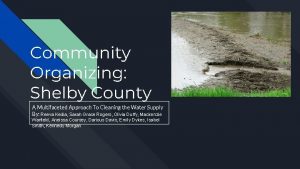A Multifaceted Approach to Understanding the Issue of













- Slides: 13

A Multifaceted Approach to Understanding the Issue of Access to Linguistically Appropriate Services in a Diverse Community Cristina Heinz, MPH, Community Health Planner: PRESENTER Besem Obenson, MPH, MBA, Senior Community Health Planner Scott Morrow, MD, MPH, Health Officer

Background: Rooted in Health Disparities n 2004 Health Disparities Summit n One of the three issues prioritized for initial focus was linguistic access in San Mateo County

Language matters in breaking down barriers to health care n “We go and do the best we can with the English we can muster. Many times you don’t understand, but just nod yes to whatever the doctor says. So, most of the time, we don’t ask questions and leave confused” -- Client, Linguistic Access Study Focus Group n “Linguistic access is a quality of care issue” -- Health Department Manager, Linguistic Access Study n “A majority of organizations rely on family and friends to interpret for their clients some of the time…” -- Staff, Linguistic Access Study

Our community’s diversity includes more than 30 primary languages n From these groups, one in four are Limited English Proficient (LEP) Total LEP Population Spanish 53, 465 35, 425 (66%) n Chinese 7, 355 (14%) Tagalog 2, 740 (5%) Russian 830 (2%) Variation by age and region of SM County Source: U. S. Department of Labor. 2000. Census special tabulation on LEP Adults. *Census reports information on Pacific Islander languages as one group. Pacific Islander* 745 (1%)

Model practices target organizational policies and practices n Clear and comprehensive written policies for: n n n n Accessible language assistance n n n Expressed commitment to serving all, regardless of language Tracking language needs of clients Right to free interpreter services Interpreter guidelines and requirements Translation requirements and guidelines Training bilingual staff Translation plan, translation standards, piloting Bilingual providers, administrative staff and interpreters Continuous quality improvement and planning

Data collection n Managers, staff, and clients from over 50 county and community-based health care organizations and programs from all regions of the County. n More than 150 clients, residents, and advocates from six LEP communities in the county also shared their perspectives. n Research included a program manager survey, staff survey, client focus groups, and interviews with community leaders.

Linguistic Access Study findings: Goal 1 - “Where we are, ” the current services and degree of adequate language assistance n Satellite clinics and programs that focus on health care needs of a single ethnic group (primarily Latinos) have the highest levels of linguistic access n Behavioral Health and Recovery Services Division has recently completed comprehensive policies and procedures on language assistance and linguistic access improvement n Significant challenges remain in meeting LEP clients’ needs n Promising practices harness capacity of community and technology

Leveraging technology: Health Care Interpreter Network Program

Linguistic Access Study findings: Goal 2 – Service gaps related to linguistic access n We have yet to achieve a community standard of linguistic access q q Many organizations, including the Health Department, lack uniform policies, procedures, and practices regarding the provision of linguistically appropriate services As a result, language assistance services are not consistently available and used at enough points of service

Linguistic Access Study findings: Goal 3 – Recommendations for improvement at both policy and organization levels n n Specify as a priority in mission, vision & values statements Create, update and post policies on provision of linguistically appropriate services q q q n Assessment of language needs at client and program level Right to free interpreter services Commitment to staff training Expand improve interpreter services and availability of translated materials q q q Priority of attracting bilingual staff Types of acceptable interpreter arrangements Translation requirements and guidelines

Moving forward n In October 2006, the Board of Supervisors approved the Linguistic Access Study results. n A Health Disparities Initiative Oversight (HDIO) group was formed with representation from all Health Department divisions to provide guidance in implementation of the study results. n In March 2007, a First Year Action Plan was developed. n The Health Policy & Planning division has been providing technical assistance and serving as a resource to divisions’ cultural and linguistic access improvement projects. n In October 2007, leadership approved the San Mateo County Health Department Cultural and Linguistic Access Standards.

First Year Action Plan n There are five key areas to the action plan based on the study recommendations: 1. 2. 3. 4. 5. Policy Standards/ Evaluation Use of Language Services Role of Bilingual Employees Non-Spanish/North County

n n Questions The complete study results are available online at http: //www. smhealth. org/hpp Thank You for Your Time!
 Multifaceted approach to health care
Multifaceted approach to health care Multifaceted role of system analyst
Multifaceted role of system analyst Evius
Evius Skyscraper model of culture
Skyscraper model of culture Understanding ekgs a practical approach
Understanding ekgs a practical approach Waterfall and sprinkler strategy
Waterfall and sprinkler strategy Traditional approach vs object oriented approach
Traditional approach vs object oriented approach Multiple approach avoidance
Multiple approach avoidance Deep learning approach and surface learning approach
Deep learning approach and surface learning approach Virtual circuit network
Virtual circuit network Cognitive approach vs behavioral approach
Cognitive approach vs behavioral approach Cognitive approach vs behavioral approach
Cognitive approach vs behavioral approach Research approach example
Research approach example Ng-html
Ng-html
